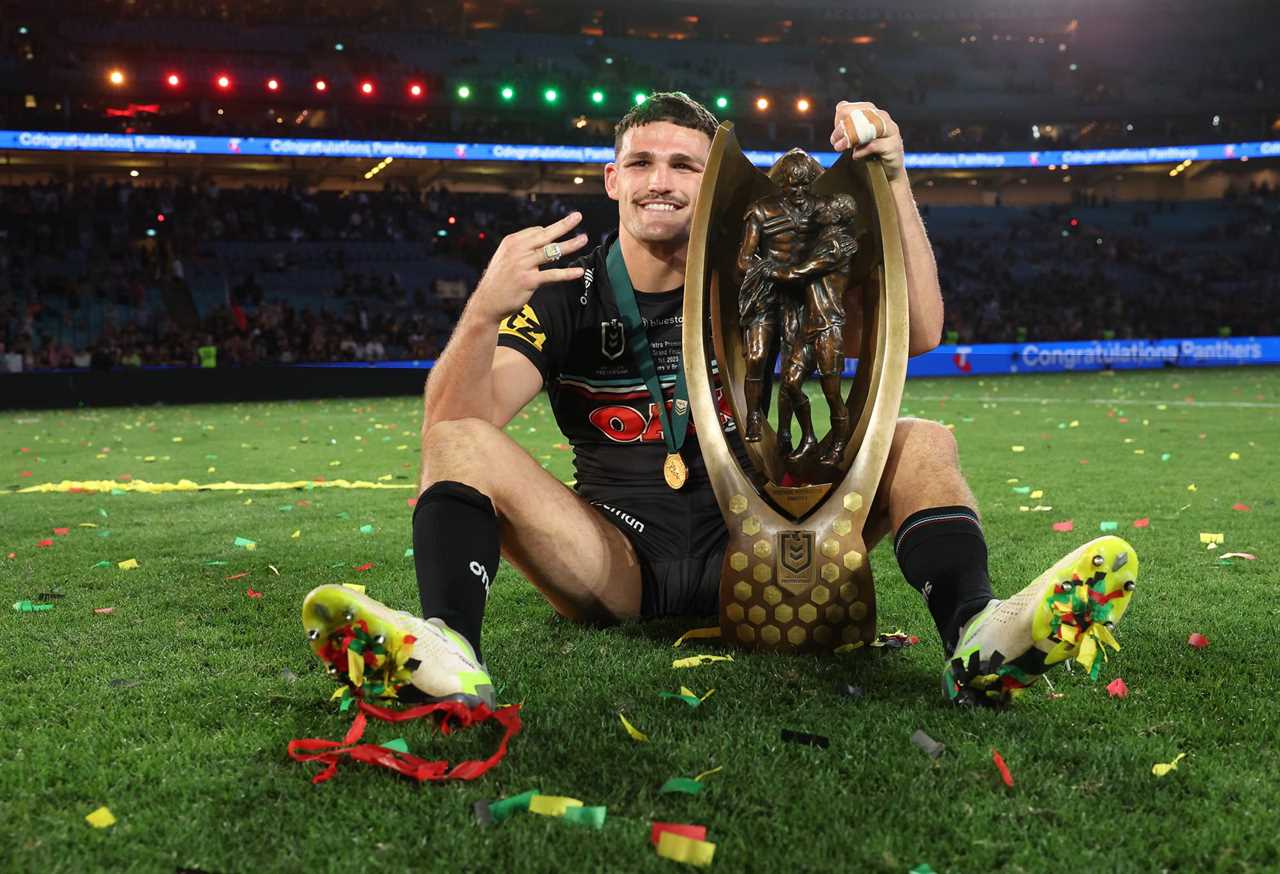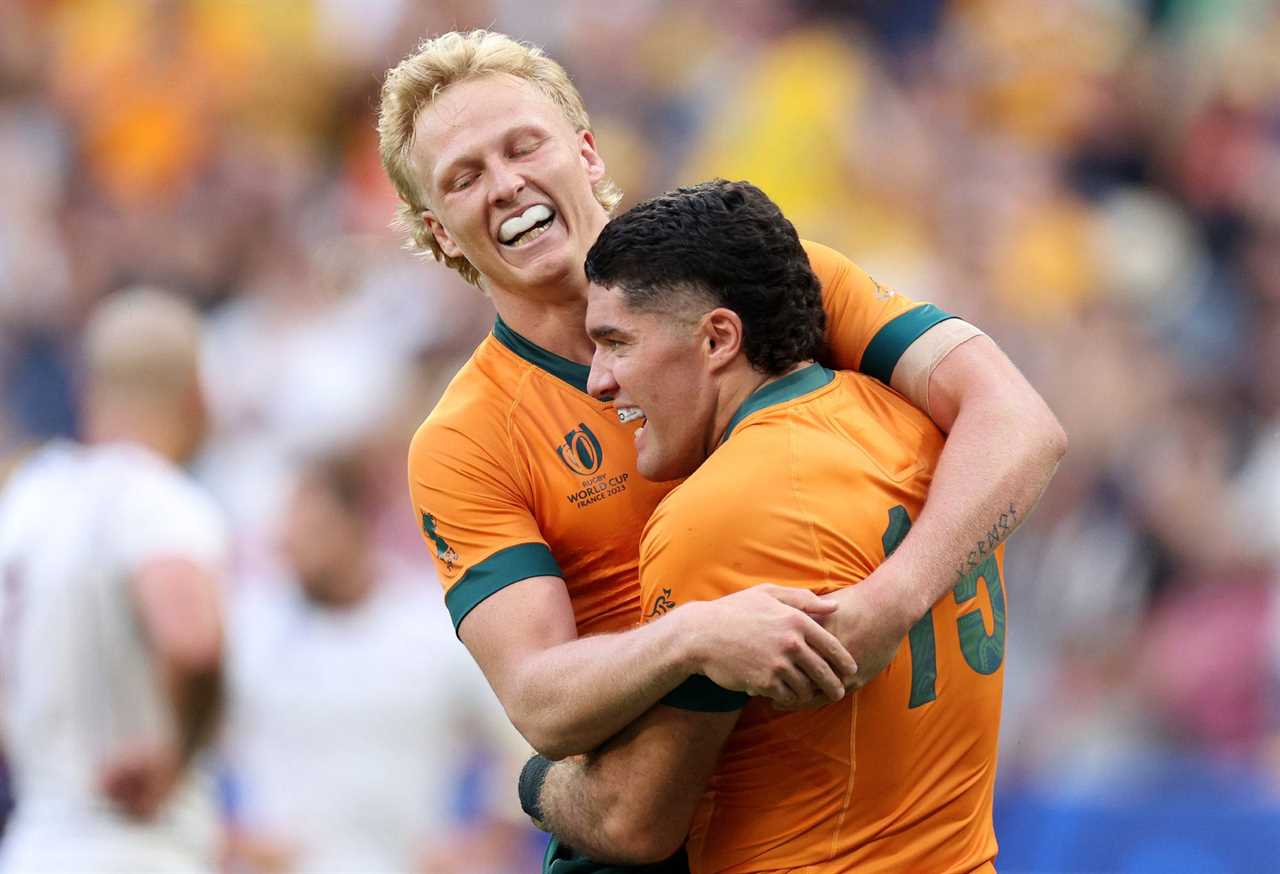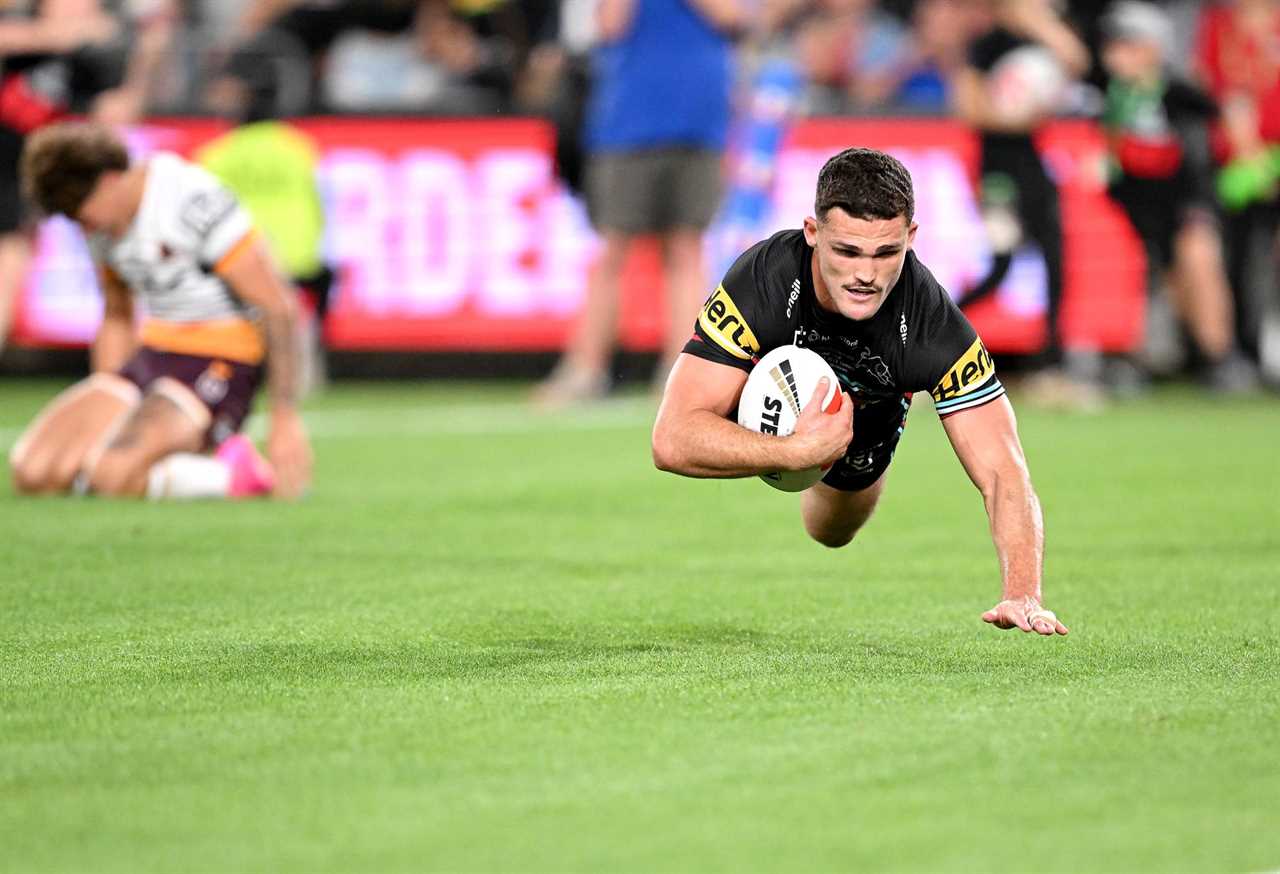Two decades ago Eddie Jones missed out on signing Andrew Johns because of a late change of heart from the then-Australian Rugby Union.
Jones has the chance to right that wrong by luring across Nathan Cleary – the best rugby league playmaker since Johns, who was inducted into rugby league folklore as Australia’s eighth immortal in 2012.
On Sunday, Cleary was the frontman to the Penrith Panthers’ incredible three-peat, as the men in black rallied from 24-8 down after 56 minutes to secure an enthralling 26-24 victory to claim the NRL title. Six hours later the Wallabies ran out in France with Ben Donaldson steering the ship and no other recognised playmaker in the squad due to Carter Gordon’s injury.
Cleary was pivotal in swinging the momentum of the NRL grand final, as his 40-20 at the hour mark added wind to their sails.
Then his decision to cut back against the grain and leave four Broncos players clutching at air in the 77th minute sealed their remarkable come-from-behind victory.
Ten minutes earlier, Cleary’s sideline conversion from out wide proved crucial in sealing their dramatic two-point victory. The 25-year-old’s goal-kicking percentage is just short of 85 per cent.
Cleary is the general Australian rugby is missing.

Nathan Cleary poses with the Provan-Summons Trophy after winning the 2023 NRL Grand Final match against the Brisbane Broncos at Accor Stadium on October 01, 2023 in Sydney. (Photo by Matt King/Getty Images)
Maybe one will appear in time without him, maybe one won’t.
But four years’ out from Australia’s home World Cup, it’s hard to see one delivering the poised match-winning performance Cleary did for Penrith for the third straight year.
Australian rugby has a crop of promising young playmakers – Carter Gordon, Ben Donaldson, Noah Lolesio, Reesjan Pasitoa, Tom Lynagh, Will Harrison, Harry McLachlan-Phillips, Jack Bowen are all younger than 25 – but can they do what Cleary did?
Can they kick at 100 per cent in a final; leave four defenders in their wake; repeatedly put kicks on the mark for attackers to run onto; drill 40-20s at precisely the necessary moment; and can they deliver in front of 80,000 fans with the pressure at its highest?
Pierre-Henry Broncan, one of the Wallabies’ assistants and a French Top 14 finalist coach, doesn’t think so. Not at the moment anyway. Defeats to Fiji and Wales showed that.

Happier times: Wallabies playmakers Carter Gordon and Ben Donaldson during their win over Georgia. (Photo by Warren Little/Getty Images)
Many, including analyst specialist Ben Darwin, say short-term thinking is how Australian rugby got itself into the mess it finds itself currently in.
He will point to the fact Cleary hasn’t played senior rugby and would have to unlearn the 20 years of acumen in rugby league, making any transition harder.
He will also argue Cleary is 25 and any playmaker wanting to transition to rugby union and succeed will have to do so before they are 20, particularly if they haven’t grown up playing the game. Remember Benji Marshall?
He will also point to the system the Panthers play in and the years Cleary has spent playing alongside his teammates from underage level to the NRL as a clear reason for the team’s success.
He will also point to Marshall’s failed transition, where he left the Auckland Blues less than a season into a two-year deal with the Super Rugby franchise because he struggled to understand the “technical aspects” of the game.
Despite that, Cleary, with two years to learn the intricacies of the game, could lead the Wallabies deep at the next World Cup. He should be Rugby Australia’s number one target.
As every international coach says, statistics in the modern game tell you that the team that kicks the most tends to win the match.
Kicking efficiently and effectively and at the right time is just as vital, with the Wallabies’ kicking the ball away aimlessly and inaccurately all year, but the stats point to the need for having generals who can kick well.
There’s no better kicker than Cleary, whose pinpoint ability has seen the Panthers profit from his accuracy.
Cleary, who would need an early release from his deal until the end of 2027, has already said he’s interested in rugby, having watched on with envy as the Matildas won the hearts of Australians.
And why not given he’s already played at the top, won NRL titles, State of Origin campaigns and rugby league World Cups?
“It does [hold interest] for sure,” Cleary said on the Sporting News/YKTY Ebbs and Flows podcast.
“I think that’s the exciting part of union, it is on that global stage.
“If you were to do it for Australia, it would be such a big thing because Australia has sort of neglected union for a while now and it hasn’t been a massive thing.
“I think that part of it is an exciting prospect, but league is all I have known and loved and it has been a passion for me.
“I couldn’t see myself doing it, but there is a little part of me that thinks it would be cool to try it out.”

Nathan Cleary dives over for the matchwinner in the 2023 NRL final against the Brisbane Broncos at Accor Stadium on October 01, 2023 in Sydney. (Photo by Bradley Kanaris/Getty Images)
While RA would have to throw a large seven-figure number at Cleary to try and lure him across, there would be several interested suitors who would likely support the deal and help contribute to his contract in a way the Rugby Foundation helped keep Israel Folau and David Pocock in rugby.
Having not spent years in the game, Cleary would need at least a 24-month runway to be in a position to not just pull on a gold jersey, but thrive in it.
He could travel with the Wallabies on an end-of-year spring tour and be eased into the game in much the same way Marika Koroibete was after jumping on board from the Melbourne Storm. Koroibete, with little rugby experience before switching codes, is a two-time John Eales Medalist.
Cleary, who has spent time working with All Blacks great Dan Carter, says he wouldn’t take a half-hearted approach to rugby union if he was to jump ship.
“If I was to try it, I would 100 per cent have to be all-in, I wouldn’t just be doing it for the thought of having success or wanting that global status,” he said.
“It would be such a process thing. It would take a lot of hard work, like I’d just have to know the game inside-out before I even felt confident pulling on an Australian jersey.
“I wouldn’t just want it because of what I’ve done in league.”
RA would come under fire for throwing money at a rugby league player when the grassroots of the game needs nurturing.
The next generation of rugby players, including the Gordons, Lynaghs and Bowens, might also feel aggrieved.
But, as Waratahs coach Darren Coleman noted earlier this year, striking a balance between having headline acts and supporting the grassroots is necessary.
“It’s a tricky one,” Coleman told the Roar Rugby podcast.
“Whenever I’ve gone to a club at the bottom, you can’t rebuild it from the bottom alone. It takes too long A) and B) if they haven’t got idols or stars you’re not going to get kids playing it.
“I genuinely feel we’ve got to do it at both ends, so we’ve got to make sure our grassroots [are strong] but as Eddie’s touched on, we’ve got to be in the top three in the world.
“We’ve got to have a Wallaby team that kids can aspire to and kids want to come and play, we’ve got to have a Waratahs team because we’re a big union in a big city, that’s at the top and they’ve got heroes and they’ve got the Phil Waughs, the Chris Whitakers and the Adam Ashley-Coopers, the Michael Hoopers, that’s what puts interest into the game.”
One thing is for sure, the Wallabies need winners and a run deep through the next World Cup will be pivotal to helping bringing the Australian rugby public back on board.
Cleary has the capacity to not just create interest, but is a winner and has the skill set to transition to the XV-player game.
https://www.theroar.com.au/2023/10/02/why-the-wallabies-shouldnt-miss-out-on-the-next-joey-and-sign-nrl-star-for-2027-rugby-world-cup/
 Backyard GrillingWeekend WarriorsAdvice from DadBeard GroomingTV Shows for Guys4x4 Off-Road CarsMens FashionSports NewsAncient Archeology World NewsPrivacy PolicyTerms And Conditions
Backyard GrillingWeekend WarriorsAdvice from DadBeard GroomingTV Shows for Guys4x4 Off-Road CarsMens FashionSports NewsAncient Archeology World NewsPrivacy PolicyTerms And Conditions
